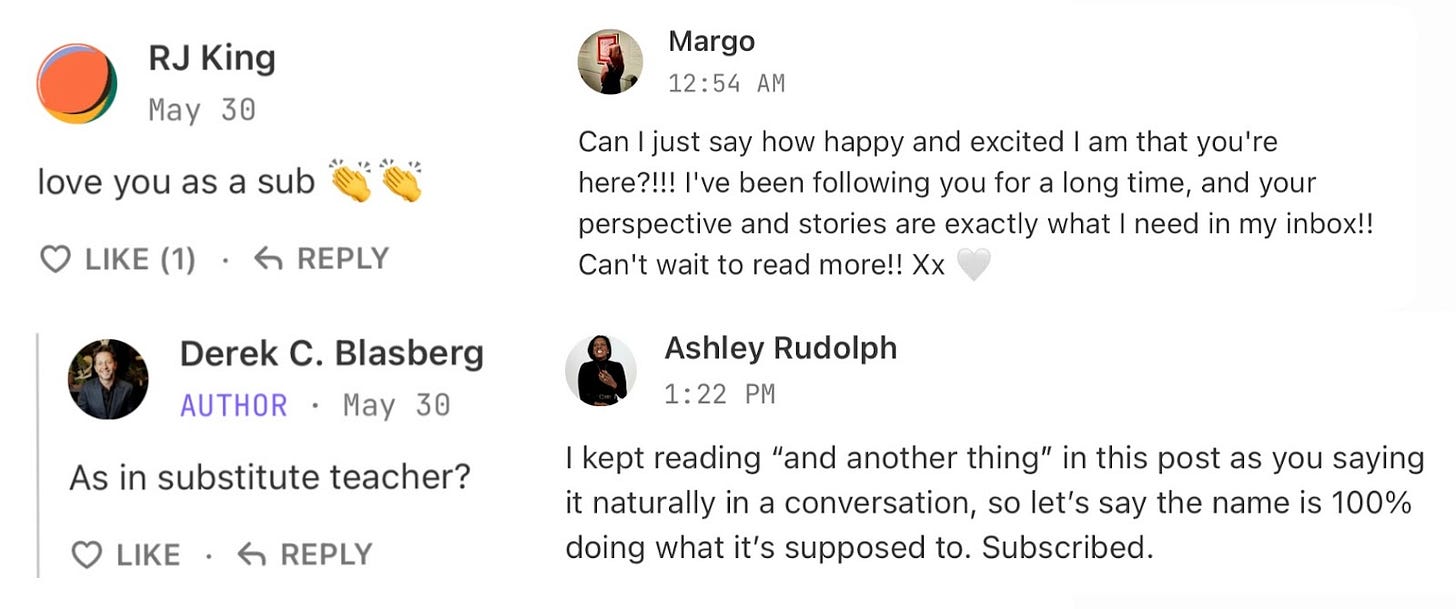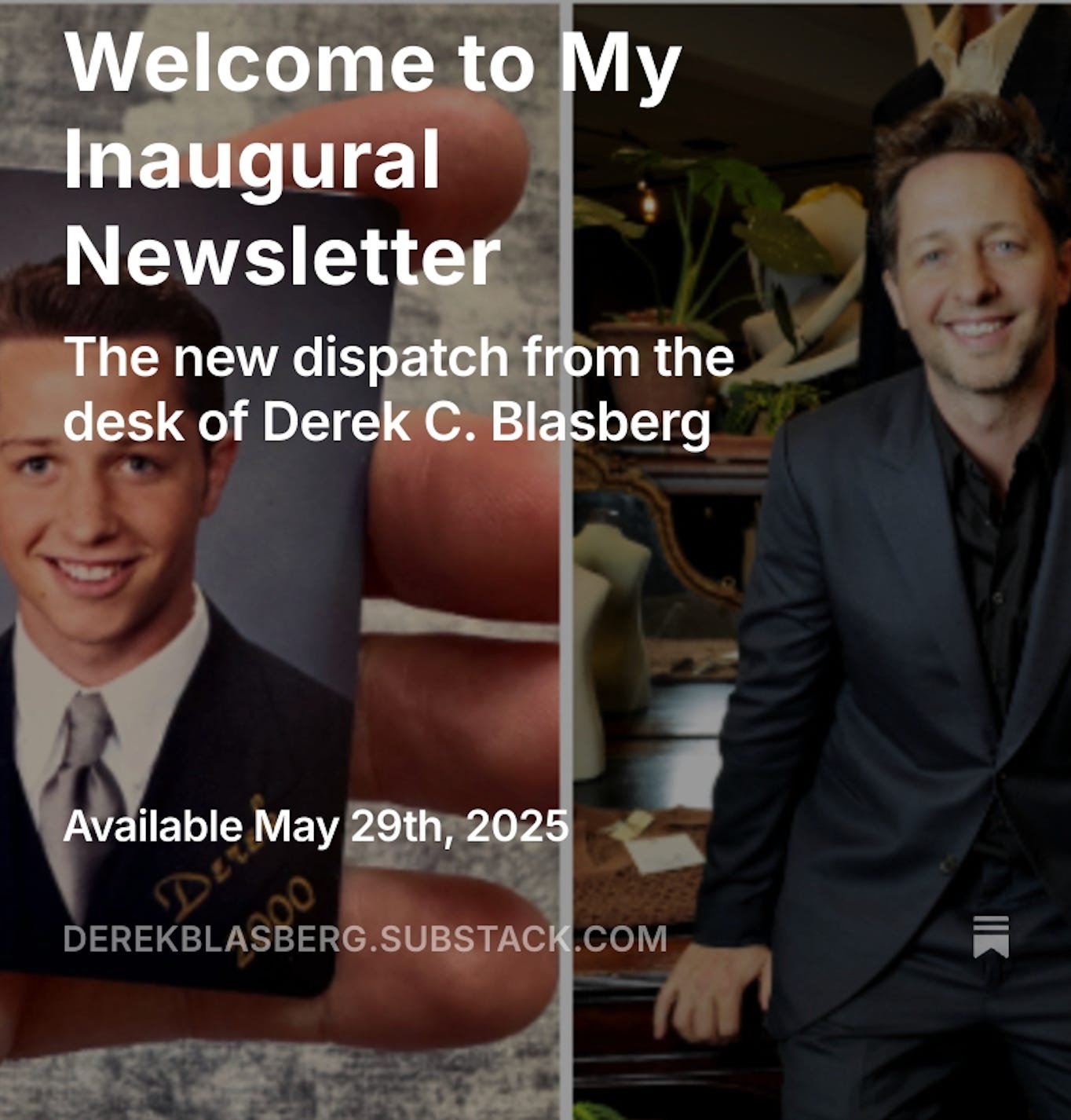Is it Nice in Here?
Everyone seems friendly on Substack. More importantly, they know the difference between YOU'RE and YOUR
First and foremost, I’d like to extend my gratitude to the Substack community for such a warm welcome. My inaugural newsletter was trending! I figured the only way to hit a trending page nowadays was to get arrested, be outed for partying with Puff Daddy, or drop dead. So, this was a welcome surprise. Maybe even a relief?
For the record, I’m at #3, two spots behind
. I got my eyes on you, Perky.After AND ANOTHER THING launched, someone asked how I arrived at my $6-per-month figure. If you didn’t know, writers set their own rates on Substack, just like Julia Roberts did in the bathtub with Richard Gere in ‘Pretty Woman.’ (There’s a Julia Roberts movie to explain everything.) My new favorite person, Austin, head of Business Development at Substack and the man behind Bangers & Jams, informed me that Substack subscriptions start at $5, and from there, the sky is the limit. At the tippy top, finance bros and crypto newsletters can charge more than $1,000 per month, which sounds like the right price for insider trading and tips on tax avoidance. (The IRS is so gutted, it’s not like it can afford a subscription.)
I wanted a monthly fee that was the equivalent to a cup of coffee, a symbolic gesture to the tone of AND ANOTHER THING, which I want to feel like a couple of pals gabbing and caffeinating. Confession: I don’t drink coffee (I think coffee breath is vile), but my Starbucks order—a Venti English breakfast tea with extra-hot steamed oat milk—costs me $7.02 every day. Since my Midwestern family remains horrified that I pay $7 for hot water, herbs, and fake milk every day, we landed on $6. (By the way, my dad is right, that is absurd. But so is almost everything about living in New York City.)
Thank you for joining me on this Substack journey. Creating something worthy of your time, not to mention your hard-earned money (or your parents’/employee expense accounts’ hard-earned money), is a daunting task that I take seriously. I’m flattered and honored to be here.
MOVING ON…
In today’s newsletter, I’m asking you to meet me in a much simpler time. I’m thinking… 2014. Close your eyes, picture it. (OK, I guess you can open your eyes so you can keep reading.) Barack Obama is president. Taylor Swift just released 1989. You’ve just figured out what “on fleek” means. “TikTok” is a Kesha banger (released in 2010, guys), not a social media platform, and Twitter isn’t X, and we haven’t all migrated over to Threads anyway. Your smartphone isn’t listening to everything you say. Pharrell just started wearing a comedically oversized 10-gallon cowboy hat and, somehow, he pulls it off. Ellen DeGeneres just took a group selfie with Meryl Streep, Bradley Cooper, Jennifer Lawrence, Lupita Nyong’o, and Brad Pitt at the Oscars.
You with me? It’s a gentler, more innocent internet. Isn’t it nice in here?
In 2014, I leaned heavily into social media, especially Instagram. Sunsets, selfies, avocado toast, all that crap. I posted at least once daily, sometimes more, and not because a tech world overlord gave me a list of “best practices.” I posted because I wanted to! It felt safe and exciting to open up my world to complete strangers, especially when I was on the road for fashion weeks, art fairs, and holidays.
For all its enlightenment, legacy media was slow to social media. I remember when Style.com (RIP to a legend) debated whether or not to launch an official Twitter account. I’ll never forget the uproar Dolce & Gabbana caused when the brand invited bloggers (a new term at the time) to sit front row at its Milan Fashion Week show. There was BryanBoy and Tommy Ton sitting on opposite sides of Anna Wintour, perched in front of their laptops. As a twenty-something aspiring fashion professional with my face pressed against the glass of my Blackberry, it was a monumental moment. Visibility matters! A decade later, New York magazine summed it up: “2009 Killed Fashion As We Knew It.”
In 2014, social media was simple: Take a pic, give it a filter (Valencia, obviously), and post it with a vaguely witty caption. I love puns, and the early algorithm loved me for it. My best-performing post from 2017 was a picture of me and Kendall Jenner at a polo match, captioned: “Shady place for sunny people.” My friend Dasha and I at a rodeo in Aspen: “Should I stay or should I poncho?” Kaia Gerber sporting big, huge, enormous hair backstage at a Valentino haute couture show: “Comb on over, baby.” A photo of me holding my friend Kelly’s daughter’s pet was titled: “You’re no bunny til no bunny loves you.”
Sure, this ain’t Hemingway. However, the captions were silly and playful, which helped me create a community of people who enjoyed both high fashion and dad jokes. These were my people.
In the mid-2010s, my punning and posting were so prolific that the New York Times did a story called “The Fabulous (Instagram) Life of Derek Blasberg.” (So long ago, media websites didn’t know how to embed social posts yet.)
Well, you know what happened next. Donald Trump’s first term fertilized the bottom of popular culture, and the public discourse got darker. In the early days, my comments were mostly kind and encouraging. Only occasionally would I be called a gay slur or told to go kill myself. However, by the end of that decade, I got “your a fag” at least once a day, which especially offended me because of the bad grammar. (“No, you’re a fag,” I’d correct them.) The friendly, funny, punny community that felt tightly knit began to unravel itself. Social media’s algorithm began to reward drama. Enragement equaled engagement. The more combative or performative something was, the more it was seen. Subtlety fell out of favor. Nuance? Never heard of her.
An internet that once celebrated wanderlust and witty captions was now bracing for the next news bomb, conspiracy theory, or public takedown. Canceling people became as ubiquitous as asking for selfies with them. By the 2020s, selfies and avocados were inappropriate. STAY HOME TO STAY SAFE. Handles became activist billboards, public health service announcements, and political statements, all while maintaining aesthetic cohesion. Was it OK to post pictures from runway shows? Or not? I don’t know! CLICK HERE TO BUY! When TikTok took off, everyone pivoted to video. Facebook Watch. Red Table Talk. Swipe up from Stories. REELS REELS REELS! Now, it’s all about AI, which is both amusing and terrifying. Did everyone see this story about how a deep fake account appropriated this influencer’s wedding by putting a digitally manufactured face on her body in her wedding dress?
The pressure can feel exhausting. Less about the grid, more about the grind.
Don’t get it twisted—it’s not like I’m not off social media. I go on Instagram every day. Yes, it all feels more polished and less spontaneous now, and passive puns are gone and replaced by fully fleshed-out slide shows. But I still love posting from my travels and my kids’ birthdays. I enjoy checking in on my friends back home and around the world, and staying up-to-date with the news in real-time. (Between us, I love a good conspiracy theory, too.) When I launched my Substack, I announced it on Instagram, Facebook, and Threads. (I got locked out of my Twitter account a few years ago, but the Customer Support was so diabolical I just gave up. So what, it’s a cesspool anyway.)
The activism we observe on social media has become a vital component of societal discourse. It’s been detrimental in some ways (doxxing, trolling, bullying in the comments), but positive in many others, such as holding public figures accountable and celebrating good Samaritans. When I can’t sleep, I go on Facebook and watch videos of U.S. soldiers coming home and surprising their parents, which make me weep like a baby. And every once in a while, a good fashion story will break through the noise: I love watching Yasmeen Ghauri, an OG supermodel who slipped away from the industry’s consciousness when she retired, slink back into the conversation as a new generation of fashion fans rediscover her notorious runway walk.
The fact is that social media has evolved from creating small, aesthetic-based communities into becoming the primary source for us to get our news, discover new brands, films, and dream travel destinations. It’s more difficult to break through, and puns don’t land as well as they used to. But, it is what it is. Deal with it. To quote Barry Diller, “Next!”
Which brings me back to Substack. I need another app on my phone like I need a hole in my head. AND ANOTHER THING is me dipping my toe into this literary pond with the hopes of finding a place where wordplay is revered, ideas come before trends, thoughtfulness matters more than thirst, and it’s possible—maybe, hopefully?—to have conversations.
What hooked me is the notion that subscriptions fuel this place, not engagement-based algorithms. Users create real logins, so trolls can’t easily create fake accounts. Actual people are engaging with people’s writing in actual ways. (At least, I think they are? Or else the AI is fabulous in here.) If not always friendly, at least the comment section is clever: more “this reminds me of Joan Didion” than “go kill yourself.” If things get hot in here, we flip a switch so only paid subscribers can leave comments. If a troll is willing to pay me $6 a month to be an asshole, I’m OK with it.
I don’t expect Substack to be perfect—nothing on the internet is. But I’m hoping this space can be a little softer, a little brighter, and a little nicer. I’ll be here writing what I think, what I feel, and what I notice from this strange, stylish, ever-scrolling world. Will I be punny? You bet. And I promise I’ll always use the correct 'you’re.'
Wow, thanks for reading all the way to the bottom! I’ll be back soon.
Derek C. Blasberg
PS. Any burning questions? Is there anything you'd like me to write about? Tell me in the comments. (I need all the help I can get.)









I love this!!! So I’m a licensed mental health counselor and I’ve worked both as a mobile crisis clinician assessing at risk children to safety plan while they’re in crisis and as an outpatient counselor working with adults. The thing I’ve noticed that has caused a lot of anxiety and stress and depression in people is the lack of communication and socializing that occurs anymore face to face. Like you were mentioning, everyone hides behind a fake user name and can say whatever they want but they miss so much in communication. They become inadequate in understanding nonverbal communication and/or how to communicate and it leads to conflict or isolation. It’s getting worse and forums where actual conversations and not hiding behind a fake picture helps go back in the right direction of learning how to be human again and not a machine.
Waoo we are really and still growing up, always. And cant wait to read more